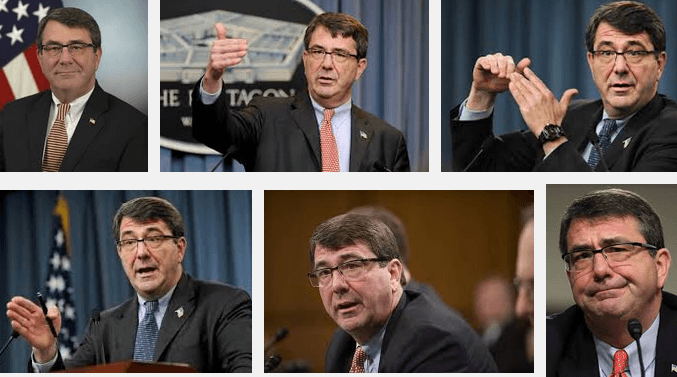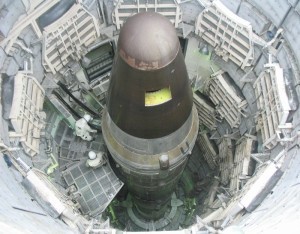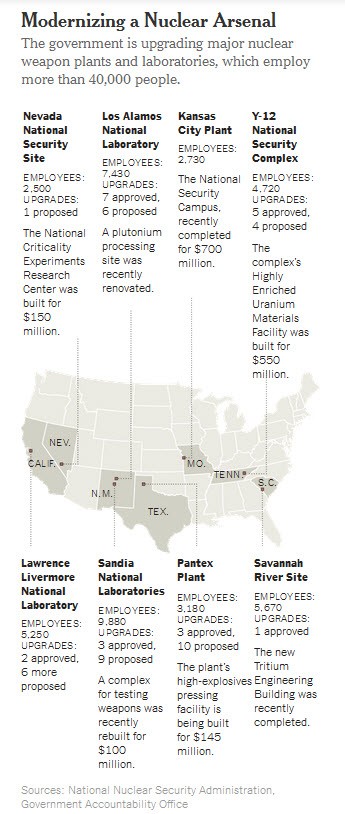Two weeks ago, we wrote of the Secretary of Defense and his last substantive decision — to ‘modernize’ the U.S. nuclear force… Now we examine the Pentagon’s next SecDef as he begins his journey to oversee the most powerful military force in history…
The recent decisions of the SecDef on nuclear arms and weapons complex (referenced below) were accompanied by the SecDef exiting his role as the Pentagon’s top man. The new man, introduced yesterday in the Roosevelt Room at the White House by the President, is Ashton ‘Ash’ Carter.
In Ashton Carter, Nominee for Defense Secretary, a Change in Direction / NYT – Dec 5
The question that comes to our mind, as we review an increasingly dangerous horizon of war and threats of escalation, is how does the new man at the Pentagon fit in with the President’s security policies, the national security strategic team and which directions will the Pentagon take?
A first-read of former Undersecretary Carter’s more public positions includes the controversial counsel to use preemptive strikes against North Korea. Clearly an Obama strategy does not exhibit unilateral, preemptive war tendencies but to what extent is the future Defense head an advocate of unilateral first-strikes and a strategic doctrine of preemptive war?
To go to the next potential escalation among many — express threats by Israel and/or the US to attack Iran in the event of a failed nuclear negotiation — to what extent is the “Bush Doctrine” of preemptive strikes and unilateral war powers supported by the new SecDef? Iran is no Iraq, and few Americans are even aware of Iran’s history, strategic role, that it is not an Arab country, and that it comes with a classic set of entangled alliances (Iran-Russia-China) and multiple Mid East/Near East/North African/African geopolitical links that will undoubtedly extend the risks and costs of any preemptive attack.
In the Ukraine, another volatile region, the civil war threatens to draw in NATO, the EU, US, Baltic States and is currently widening rapidly in the form of financial decisions and sanctions. Previous treaties are being abrogated (including regarding tactical nuclear weapons) while a number of newly elected members of the US Congress are advocating war on this front. This past week’s State of Russia speech by Vladimir Putin raises the stakes, as have any number of recent multi-year, trillion dollar energy deals between Iran-Russia-China. The stakes of the South Caucuses routes for oil/gas delivery, natural gas and Turkey’s “South Stream” role in the region, are additional critical economic/strategic factors that are coming to the forefront of East-West conflict.
The upcoming Congressional confirmation hearings could be as revealing of armed service committee predilections as it is of nominee Carter’s pre-confirmed willingness to go on record regarding the many hot spots, threatened escalations, and political sub rosa that operates mightily behind the scenes of the headlines.
Our focus is on nuclear issues and the threats (by the US and/or allies) to develop a next generation of “useable nukes”… a “reviving” of nuclear war scenarios as now being envisioned, debated and supported by elements within the defense and political establishment.
Two recent LA Times articles focusing on an “aging” nuclear weapons system complex has brought public attention to a debate that has rarely been joined since the days of the Cold War. Now comes another page in an existential threat story of humanity under a wavering Sword of Damocles as treaties are set aside and previously agreed drawdowns of nuclear warheads are abandoned. A new hardened attitude is once again being exhibited and ostensibly ‘useable’ nuclear weapons that are described ‘precise’ and ‘bunker-busting’ are spoken of as if they are ready-for-use tomorrow… and in fact forward deployment of these systems is a reality today.
Our vision goes toward a ban on nuclear weapons, not toward next-generation ‘useable’ nukes. The need again is for an overarching strategic thinking (what did President Reagan propose at Reykjavik?), a connected strategic vision where security is mutually shared. Certainly nuclear weapons bring home this point that the use of, or threat to use these weapons does not deliver security. Building on several decades of nuclear weapons reduction is now called for more than ever. The incoming Secretary of Defense hopefully brings a realization that the use of nuclear weapons is no security strategy, but an insecurity reality.
□
November 22 – redux
It does not need emphasis — the brewing Cold War is turning hotter…
-=-=-=-=-=-=-=-=-=-=-
[I]t is critical to take a hard look at nuclear escalation
We hear President Putin speaking of Russia’s nuclear weapons as he discusses relations and we see President Obama changing policies regarding the U.S. nuclear weapons complex. We read a Putin statement: “I want to remind you that Russia is one of the most powerful nuclear nations”, and in turn the U.S moves to increase funding of ‘upgrades’ to its nuclear arsenal.
Fact: The U.S is now proposing a trillion dollar extension of its nuclear weapons complex.
This multi-year, multi-billion dollar ‘upgrade’ to the nuclear weapons system should be seen as a continuation of nuclear weapons capacity as it maintains and reshapes the assured destruction policies of a half century of Cold War…
New iterations of ‘useable’ nuclear weapons are additionally being designed and introduced, new deployments are foreseen, the edge of a ‘new Cold War’ is impacting international strategic policy in the form of nuclear weapons spending and projections.
National Nuclear Security legislation – news & citations
U.S. and Russia increase the number of deployed nuclear warheads
_____________________________________
From NPR — Sec of Defense Hagel To Announce Massive Shakeup Of U.S. Nuclear Forces — Nov 14, 2014 / Associated Press
Hagel’s reviews concluded that the structure of U.S. nuclear forces is so incoherent that it cannot be properly managed in its current form
- a combination of problems amount to fundamental flaws
- billions of dollars more will be needed over the next five years to upgrade equipment
Months of warnings that the U.S. nuclear weapons system is in a state of disarray
proceeds the following release, focusing on ICBM’s, from one of the respected nuclear weapons complex monitoring groups, Los Alamos Study Group
For immediate release 11/14/14
DoD Reviews of Nuclear Weapons Operations Largely “Management Clichés,” Fail to Address Core Problems, Group Charges
Albuquerque – Today’s long-expected internal and external reviews of the Department of Defense (DoD) nuclear operations do not address the root causes of the operational lapses that plague DoD nuclear forces, the Los Alamos Study Group charges.
An article this morning by Robert Burns and Lolita Baldor of the Associated Press explains the basic outlines of today’s announcement by Secretary Hagel.
According to AP, Hagel told his listeners that the good news “is there has been no nuclear exchange in the world.” Likewise Adm. Cecil Haney, Commander in Chief of STRATCOM said, “You don’t see the mushroom cloud or that sort of thing. We must continue that.”
Hagel said, “The root cause [of the persistent problems discovered] has been a lack of sustained focus, attention, and resources, resulting in a pervasive sense that a career in the nuclear enterprise offers too few opportunities for growth and advancement.”
Hagel told reporters the cost of implementing the improvements planned would increase DoD nuclear costs by about 10% per year.
A December 2013 study by the Congressional Budget Office (CBO) tallied the 10-year cost of DoD’s portion of nuclear weapons expenses at $19.2 billion (B) (p. 2; for more detail see p. 5). A 10% increase in these costs thus comes to about $2 B per year or $10 B over the annual 5-year budget Future Years National Security Plan (FYNSP).
Based on past experience, CBO foresaw $30 B in cost escalation over DoD’s budgeted expenditures of $191 B over the coming decade, due to underestimation of acquisition costs. Today’s announcement concerns operational costs and deferred maintenance rather than acquisition, so the 10% increase announced would add about $19 B to CBO’s estimate of overall DoD nuclear weapons costs over the coming decade.
Study Group Director Greg Mello: “In today’s announcement the frightening disconnect between the world of nuclear command and the world of human beings is fully apparent. That, not management, is the “root cause” of the problems.
“If the ‘good news’ is that there has been ‘no nuclear exchange’ and no ‘mushroom cloud,’ to quote Secretary Hagel and the STRATCOM chief today, we know the bar is set too low. There could hardly be more revealing comments. It is the mission, not the management, which is the core of the problem. Dysfunctional management has evolved to fit the dysfunctional mission.
“The way to get rid of problems in the ICBM force is to get rid of ICBMs. They comprise the most absurd leg of the triad. That will save a lot of money as well, though money is secondary to the increased security such retirements would bring.
“These studies had to be done, and I am sure they were done as conscientiously as possible by smart, experienced people. Even so, the final result is riddled with what amount to management clichés and rah-rah boosterism.
“No amount of money or silly made-up medals will ever lead to ‘good morale’ in ICBM officers in particular, who must sit in a deep hole in the ground awaiting orders to end the world. The mental gymnastics of nuclear deterrence theory do not make human sense to those who must live, day and night, in an inhuman environment with world-ending orders locked in a box in front of them…
“Will the additional billions proposed create more national security? No. They will disappear into the same futile and misdirected black hole as the previous billions. Will morale improve? No. Contractors will be enriched, and the generals will have the satisfaction of knowing that ‘something has been done.’ But the problems will persist.
“There is no reason to think today’s ICBM force is any more dangerous than it has been at all times in the past. There is no accumulation of danger. Danger is the object of the exercise, and there have always been severe morale problems, accidents, and so on.
“It is quite possible that upgrades of old command and control systems will introduce new dangers, so DoD must be very careful. The introduction of new dangers during upgrades is commonplace. The biggest cause of problems is often solutions.
“I think any honest person with an ounce of common sense realizes that the only real path to higher morale in the nuclear weapons business lies in gradually shutting it down, starting with the most stupid parts first. The hope that the nuclear sword of Damocles can finally be lifted, reinforced by gradual progress, is what can bring higher morale — and only that…
“No amount of investment in a fundamentally bad idea can make it good. Caliban doesn’t become Prospero with new suit of clothes. The man on a pale horse doesn’t become our friend just because we buy him a shiny new scythe.”
◊
What of International Law on these weapons?
Here is how the UN addresses THE LEGALITY OF THE THREAT OR USE OF NUCLEAR WEAPONS
Advisory Opinion of 8 July 1996
The Court handed down its Advisory Opinion on the request made by the General Assembly of the United Nations on the question concerning the Legality of the Threat or Use of Nuclear Weapons.
◊
Far from this rarely considered, eminently unenforceable, International Law is an on-the-ground reality of a gathering era of nuclear weapons development and deployment.
The ‘grand game’ of today’s post Cold War, new Cold War era, aligning interests (and entangling alliances) of developed and developing nations, and challenging the hegemony of post WWII American dominance, presents conditions of alarm, not only as major powers (China/Russia/Iran) re-calculate but also as nuclear players publicly threaten war.
It is not an understatement to state that the ‘modernization’, increased spending, and speed-up of nuclear weapons arsenal development, accompanied by breakdown in non-proliferation progress, together do not auger a coming age of peaceful progress.
◊
U.S. Ramping up Major Renewal in Nuclear Arms
KANSAS CITY, Mo. — A sprawling new plant here in a former soybean field makes the mechanical guts of America’s atomic warheads. Bigger than the Pentagon, full of futuristic gear and thousands of workers, the plant, dedicated last month, modernizes the aging weapons that the United States can fire from missiles, bombers and submarines.
It is part of a nationwide wave of atomic revitalization that includes plans for a new generation of weapon carriers. A recent federal study put the collective price tag, over the next three decades, at up to a trillion dollars.
This expansion comes under a president who campaigned for “a nuclear-free world” and made disarmament a main goal of American defense policy…
“The most fundamental game changer is Putin’s invasion of Ukraine,” said Gary Samore, Mr. Obama’s top nuclear adviser in his first term and now a scholar at Harvard. “That has made any measure to reduce the stockpile unilaterally politically impossible.”
That suits hawks just fine. They see the investments as putting the United States in a stronger position if a new arms race breaks out.
♠
Continuing on the risks of a new Cold War with weapon modernization and deployments, lapses in the disarmament process, breakdown of nuclear non-proliferation progress (see Center for Nonproliferation Studies), potential failure of nuclear talks with Iran seen against a background of ongoing P5+1 and Israeli threats, escalating regional war, new international alliances bringing together nuclear stakeholders, a spreading global war against terror that has deeply engaged nuclear power Pakistan and its neighbors, and a ramping up of nuclear forces after years of ramping down… the nuclear threat environment has become closer to a flash point.
Recent events give a glimpse into the reshaping of nuclear contours that is in process.
♠
UNITED NATIONS, Aug 30, 2014 (IPS) – As the United Nations commemorated the International Day Against Nuclear Tests this week, Secretary-General Ban Ki-moon lamented the fact that in a world threatened by some 17,000 nuclear weapons, not a single one has been destroyed so far.
Instead, he said, countries possessing such weapons have well-funded, long-range plans to modernise their nuclear arsenals. Ban noted that more than half of the world’s total population – over 3.5 billion out of more than seven billion people – still lives in countries that either have such weapons or are members of nuclear alliances.
“As of 2014, not one nuclear weapon has been physically destroyed pursuant to a treaty, bilateral or multilateral, and no nuclear disarmament negotiations are underway,” he said.
There are still eight countries – China, North Korea, Egypt, India, Iran, Israel, Pakistan and the United States – yet to ratify the Comprehensive Nuclear Test Ban Treaty (CTBT), whose ratification is required for the treaty’s entry into force.
———————————————
Comprehensive Test Ban Treaty
CTBT ratification still uncertain after 15 years of advancement
Nov 21, 2014
There is still no timetable for when the Comprehensive Nuclear-Test-Ban Treaty (CTBT) will appear before the US Senate for ratification …
—-
Moscow stands for early ratification of CTBT treaty by all states
ITAR-TASS – Nov 20, 2014
Re: Universal status of the Comprehensive Nuclear Test Ban Treaty (CNBT)
—-
Comprehensive Nuclear-Test-Ban Treaty: Background and Current Developments
—-
Russia lauds US participation in NPT International Conference
ITAR-TASS – Nov 19, 2014
The dialogue “is holding on strategic stability, the work of five nuclear powers, preparations for the upcoming NPT Review Conference
—-
Arab countries call Israel to join NPT
Kuwait News Agency – Nov 21, 2014
VIENNA, Nov 21 (KUNA) — The Arab Group in Vienna called on Israel Friday to join the nuclear Non-Proliferation Treaty (NPT)
◊
Well, as the Swords of Damocles (yes, plural) continue to hang by threads, we say adieu for this week.
StratDem will return with WarTimes next week…







“John S. Foster Jr., former director of Lawrence Livermore National Laboratory and chief of Pentagon research during the Cold War, said the labs should design, develop and build prototype weapons that may be needed by the military in the future, including a very low-yield nuclear weapon that could be used with precision delivery systems.”